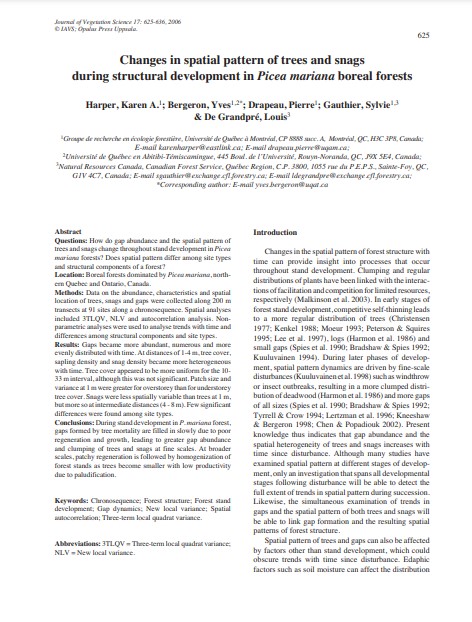Changes in spatial pattern of trees and snags during structural development in Picea mariana boreal forests
Bosque Modelo:
Lake Abitibi
Temática:
Gestión forestal
Tipo de documento:
Artículo científico
Resumen
Questions: How do gap abundance and the spatial pattern of trees and snags change throughout stand development in Picea mariana forests? Does spatial pattern differ among site types and structural components of a forest?
Location: Boreal forests dominated by Picea mariana, northern Quebec and Ontario, Canada.
Methods: Data on the abundance, characteristics and spatial location of trees, snags and gaps were collected along 200 m transects at 91 sites along a chronosequence. Spatial analyses included 3TLQV, NLV and autocorrelation analysis. Nonparametric analyses were used to analyse trends with time and differences among structural components and site types.
Results: Gaps became more abundant, numerous and more evenly distributed with time. At distances of 1-4 m, tree cover, sapling density and snag density became more heterogeneous with time. Tree cover appeared to be more uniform for the 10- 33 m interval, although this was not significant. Patch size and variance at 1 m were greater for overstorey than for understorey tree cover. Snags were less spatially variable than trees at 1 m, but more so at intermediate distances (4 - 8 m). Few significant differences were found among site types.
Conclusions: During stand development in P. mariana forest, gaps formed by tree mortality are filled in slowly due to poor regeneration and growth, leading to greater gap abundance and clumping of trees and snags at fine scales. At broader scales, patchy regeneration is followed by homogenization of forest stands as trees become smaller with low productivity due to paludification.
Información Bibliográfica
Autor:
Harper, KA, Y Bergeron, P Drapeau, S Gauthier and L De Grandpré.
Revista:
Journal of Vegetation Science
Año:
2006
N°:
5
País :
Canadá
Páginas:
625 - 636
Volumen:
17
Idioma:
Ingles
Palabras claves
Chronosequence; Forest structure; Forest stand development; Gap dynamics; New local variance; Spatial autocorrelation; Three-term local quadrat variance.





